This is the website of Abulsme Noibatno Itramne (also known as Sam Minter).
Posts here are rare these days. For current stuff, follow me on Mastodon
|
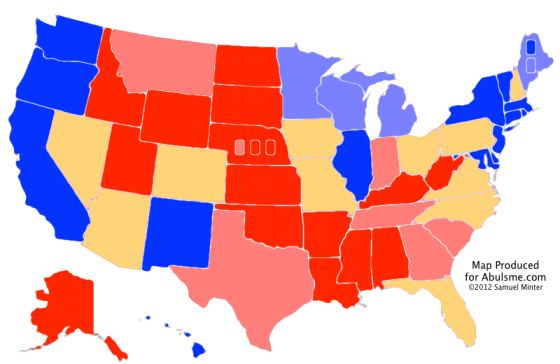
Map from the Abulsme.com 2012 Electoral College Prediction page. This map reflects Obama vs Romney. If any other candidate takes the lead in the Republican delegate race we’ll switch to making maps for them.
So on February 19th our five poll average for Washington state had Obama’s lead dip below 10%, moving them from Strong Obama to Weak Obama. Today another poll puts Obama’s 5 poll average back over 10%, so we put the state back in the Strong Obama category. Either way, just above or just below 10%, Washington is nowhere near being a swing state.
Since this doesn’t affect the inventory of swing states, the overall summary is the same:
|
Romney |
Obama |
| Romney Best Case |
311 |
227 |
| Current Status |
210 |
328 |
| Obama Best Case |
170 |
368 |
And the chart over time…
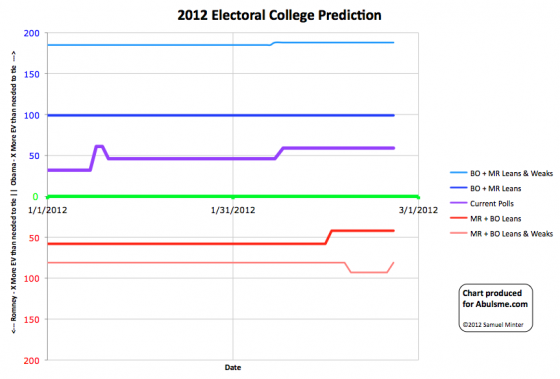
Chart from the Abulsme.com 2012 Electoral College Prediction page. Lines represent how many more electoral votes a candidate has than is needed to tie under several different scenarios.
OK, we have a couple states coming up in the next week, and a lot has been made about what happens if Santorum wins, etc. Now, a lot of that analysis is based on the momentum Santorum would gain going into Super Tuesday, but lets just look at the delegates for a minute, and see what would happen under various scenarios.
First thing to remember for all this is the way the delegates are allocated. Arizona is winner takes all with 29 delegates at stake. Michigan is more complicated. 30 delegates are at stake. A grand total of TWO delegates are determined proportionately based on the state wide primary results. (So these will almost certainly just be 1 each to the top two candidates unless it is a blow out.) The other 28 delegates are allocated winner take all by congressional district. Michigan has 12 congressional districts, each district determines 2 delegates. So in Michigan, the delegate result depends quite a bit on how candidate’s support is distributed geographically, the overall statewide numbers will not tell the whole picture.
Second item before we start looking at scenarios… where we are in the polls right now:
And of course the starting point for all this is the current state (as of February 25th) on my Delegate Count page. (Sources and methodology and such explained there.)
OK, so now looking at a few possibilities, in order from best for Romney, to best for Santorum. Note that the actual results will not likely exactly match any of these scenarios, but rather these give several types of results that characterize the kinds of outcomes that might happen.
Scenario 1
First up, current polling, plus Romney’s support in Michigan is uniform across the whole state, so he wins all of the congressional districts too. Result in this scenario, Romney gets 58 delegates for the night, Santorum gets 1.
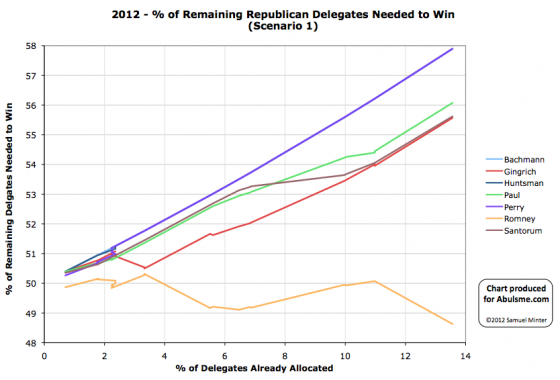
OK, obviously Romney is the big winner here. He moves down (toward the nomination) significantly. He only needs about 48.6% of the remaining delegates to win. The closest competition would still be Gingrich, although Santorum would only be one delegate behind. Gingrich and Santorum would both need about 55.6% of the remaining delegates to catch up and win. Still not an impossible number if Romney completely collapses, or even if one of them drops out and the other gets all their support (plus a bit). And with some wins in big winner take all states, it could be done. But 55.6% is starting to be a big number. And it is a LOT more than the 14.5% of the delegates these two would have gotten so far. The “catch up and win” possibility gets much further away with this result. And even the “Stop Romney from winning” possibility gets further away, as Romney continues to pile up the delegates.
Scenario 2
OK, now lets take current polling, but pretend the results in the various districts is such that the districts divide in about the same way as the popular vote goes between the two top candidates. Essentially in this scenario, Romney and Santorum split Michigan with 15 delegates each. (And Romney still wins Arizona.) So for the night, Romney gets 44 delegates and Santorum gets 15. Please note, and this is important: You get essentially the same result here regardless of who actually wins the state popular vote! As long as it is close, and the candidates essentially split the congressional districts, you get this sort of result. Depending on how many CDs are actually won by each candidate, you move the numbers a little, but the essential result is the same. With this kind of result, the state popular vote bragging rights matter ONLY to the media narrative that will build (and therefore any effects on later contests)… but they do NOT matter to the actual delegate numbers.
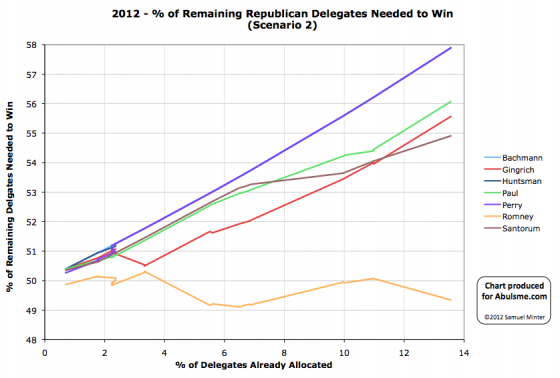
Romney is still the only winner here. It is clearly not as big a win, but Romney still makes his “% of remaining delegates needed to win” go DOWN, and go down to under 50%. Santorum, despite getting some delegates, is still in a worse position than when he started the night. Before he needed 54.1% of the remaining delegates to catch up and win the nomination, now he needs 54.9%. Santorum does pull ahead of Gingrich though, and put himself clearly into second place. But the three non-Romney’s in this situation are still all heading upward (toward being mathematically eliminated), none of them has started to actually move down toward catching up and winning. Romney in this situation does improve a bit here, but also still isn’t breaking out downward yet. He is still hovering in the zone where his opponents (collectively) only have to do a little bit better to block him from getting the nomination. Note that they do have to do better though. Paul, Gingrich and Santorum could keep getting delegates at the same rate, and Romney would still get the nomination, it would just take awhile.
Scenario 3
OK, now lets say Santorum reverses the poll momentum and ends up winning the popular vote in Michigan. As mentioned above, if his support is “lumpy” around the state, and both Romney and Santorum end up getting significant numbers of delegates, then we just have Scenario 2, plus or minus a few delegates depending on exactly how many congressional districts each candidate wins. So for this scenario, lets pretend that Santorum actually wins with his support uniformly distributed across the state and Romney wins no congressional districts. Then we have Santorum getting 29 of the state’s delegates, and Romney getting only 1. So for the night that would make it 30 delegates for Romney, 29 for Santorum. Note that despite Santorum “winning” Michigan, Romney still gets more delegates for the night because of Arizona and the 1 proportional Michigan delegate.
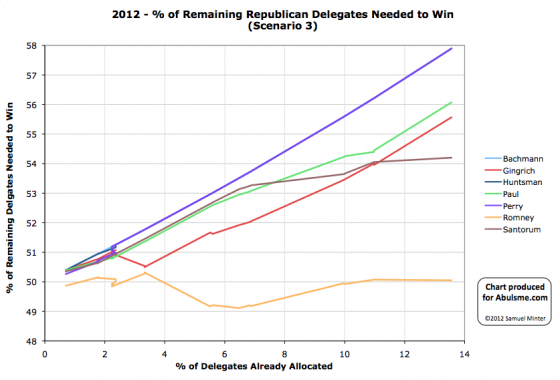
Romney is STILL the only actual winner in this situation… although just barely. He goes from needing 50.07% of the remaining delegates to win, to needing 50.05% of the remaining delegates to win. Essentially he is flat.
Santorum, despite winning Michigan in a pretty convincing way, is still worse off than coming into the day. Going in he needed 54.1% of the remaining delegates to win, now he needs 54.2% of the remaining delegates. But essentially this is flat. Once again though, Santorum does pull head of Gingrich (by an even bigger margin than Scenario 2 of course) and plants himself solidly in second place. (Although still quite a long ways back from Romney).
This scenario does however keep Romney hovering around the 50% of remaining delegates needed to win line, while having gotten just 50% of the delegates so far. This is the path to getting 1144 at the last possible moment before the convention. Obviously Romney would like to do a bit better than that as just the slightest misstep at this rate of delegate collection could cause him to end up just short of the magic number.
Scenario 4
OK, now lets imagine that Santorum comes back from behind unexpectedly in Arizona, but at the same time Romney consolidates Michigan and wins there in every congressional district. Since this involves momentum going in different directions in different states, this seems unlikely, but lets include it for completeness.
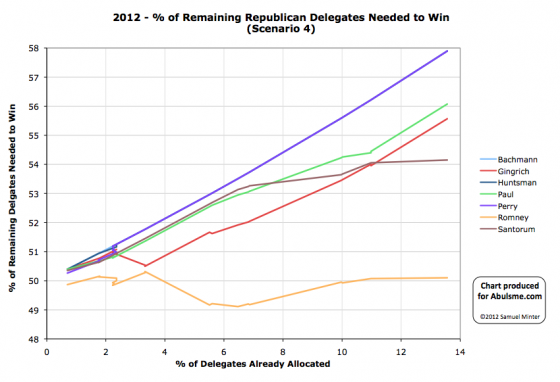
In this scenario EVERYBODY LOSES. Nobody gets enough delegates to actually be on a pace to win the nomination. Santorum does pull ahead of Gingrich, so there is that. And he does win the night. But just barely. And not by quite enough to actually be catching up fast enough to get to 1144.
Scenario 5
Romney and Santorum split Michigan (either might win the popular vote, but they split the congressional districts), but Santorum does a come from behind victory in Arizona. So for the night we get 44 delegates for Santorum and 15 for Romney.
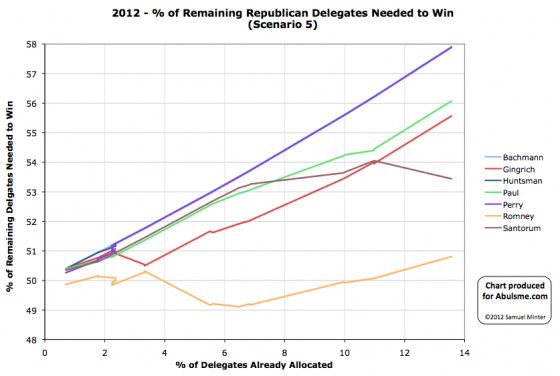
We now for the first time have a situation where Santorum actually clearly wins the night. His “% of remaining delegates needed to win” actually drops… from 54.1% down to 53.4% of the remaining delegates. Meanwhile, Romney gets knocked backwards. Rather than needing just 50.1% of the remaining delegates he now needs 50.8%.
Now, Romney is still in the lead here, and by a decent margin, but with a result like this for the first time since Gingrich won South Carolina, someone would actually be improving their position in the race versus Romney.
Scenario 6
Once again we imagine the Santorum upset in Arizona, but this time combine it with the widespread win in all Michigan congressional districts. This is Santorum’s dream scenario. Here he gets 58 delegates for the night compared to only 1 for Romney.
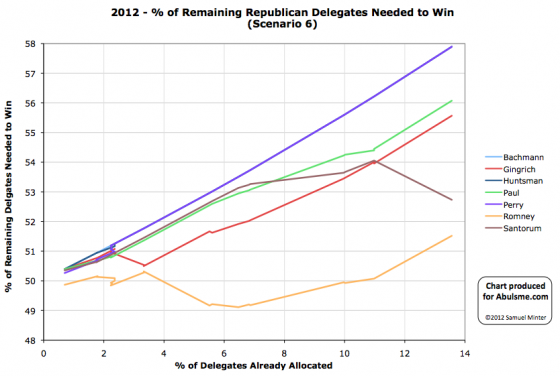
Here Santorum wins the night decisively.
After a night like this, Romney would still be ahead, but would be back below 50% of the delegates allocated so far and he would actually be moving quickly away from the nomination rather than closer to it, and Santorum would be gaining at an alarming rate. Of course, winning a winner take all state, plus almost all of the delegates from another state will do that. Romney would be in deep trouble in this scenario and while sell behind, Santorum would now be nipping at his heels.
Conclusion
All the hype is about Michigan because it is close. And because a Santorum win there will get everybody excited about “momentum”. And indeed, that kind of victory followed by the media frenzy that followed, could indeed move poll numbers in the subsequent states, most critically the Super Tuesday states…
But in terms of where the delegate race stands today, Michigan is not enough. For Santorum to actually get a substantive victory on Tuesday, not just one that he hopes will lead to bigger victories down the line, then he HAS to win Arizona too. The only situations where Santorum is actually on a pace to win the nomination himself are ones where he wins Arizona as well as a substantial number of the congressional districts in Michigan. Even with a widespread win in Michigan where Santorum wins all 14 congressional districts, if he loses Arizona, then Romney still gets more delegates for the night, and Santorum isn’t on a pace to catch up.
Of all the scenarios above, my best guess is that we will be closest to Scenario 2 than anything else. Which would mean that regardless of the state wide popular vote winner, Santorum and Romney split the Michigan delegates, and Romney wins Arizona. Which is a win for Romney in the delegate race, and by a decent margin.
Of course, if Santorum does win Michigan’s overall state popular vote, expect all the talk to be about that and the momentum he gets out of it. We won’t hear much about how actually Romney is closer to the nomination than he was before, even despite the Michigan result.
If Santorum does pull off a surprise in Arizona though… well, that is a completely different story.
Edit 2012 Feb 26 16:02 UTC for minor wording clarification.
Edit 2012 Fev 29 14L57 UTC to fix typo.
OK, beating a dead horse a bit, but I finally made graphs, so one more look. (Previous comments on this here and here, 2012 Delegate race here, 2008 Delegate races here.)
The key is that while if you look at the calendar, and say where were things on February 22nd 2008…
On the Republican side you’d see that McCain had for all intents and purposes wrapped things up. On that date 60.4% of the delegates had already been allocated. McCain had 63.9% of the delegates, while his closest competition (Romney) only had 19.9%. In order to get to his magic number McCain only needed 29.0% of the remaining delegates. For Romney to catch up, he would have needed 96.0% of the remaining delegates. Romney was just days away from being mathematically eliminated (that would happen on February 26th).
Meanwhile on the Democratic side, 64.1% of the delegates had been allocated. Obama had 50.8% of the delegates to Clinton’s 48.2%. To win Obama needed 48.6% of the remaining delegates, Clinton needed 53.3% of the remaining delegates. Clearly the Democratic race was still close (although from here on out, Obama just increased his lead, Clinton never really made up any ground except when Florida’s delegates were reinstated near the end). But the Republican race was over.
You’d then compare to Romney today and build a narrative of Romney not being able to close the deal, of wondering why he can’t just wrap this up, after all McCain had wrapped this up by this time, right?
But this year, on the Republican side, as of today we only have 11.0% of the delegates allocated (and that counts estimates from caucus states, it is less without that). So how does this year look and compare with 2008 when you look at it by % of delegates allocated instead of by date?
Well, here is the “% of remaining needed to win” chart with % of delegates allocated on the horizontal axis instead of date:
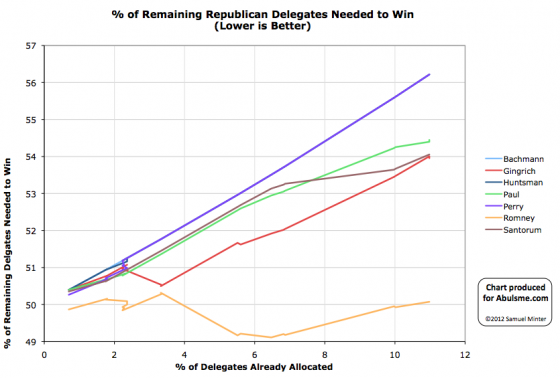
You can see clearly that Romney is well ahead of his competition, and while he isn’t yet diving down toward zero (indicating he is heading quickly to the nomination) he is holding steady, while everybody else is trending upward toward being eliminated. Gingrich and Santorum are neck and neck for 2nd place and both need about 54% of the remaining delegates to catch up and win. 54% is not an impossible number in a two man race. It is a lot better than either has done so far, but if one of them stops getting delegates and the other picks up all of their support, it is in the realm of the possible. But it would be a significant change from what has happened so far. Note, for instance, that even when Santorum won states, he didn’t win by a big enough margin to actually be catching up. His line still went up.
Now what did this look like in 2008? The closest comparison for the Republicans would be as of February 5th… the day before Super Tuesday. At that point 9.4% of the delegates had been allocated.
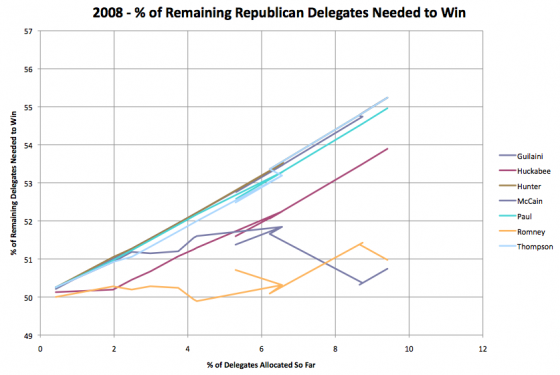
What do we see here? A very different pattern. McCain had only recently (in terms of % of delegates) pulled ahead, but Romney was still close… and gaining! We had a two person race where both were within shooting distance of each other, and neither were yet heading either rapidly up or down on this chart, indicating that they were either on the way to elimination or to the nomination. In 2008 at this point, things really were still close. The very next day, on SuperTuesday, McCain would essentially run away with it, and that would be that. But comparing comparable points in the delegate race, Romney actually has a much bigger lead and advantage on his competition than McCain had in 2008.
One more comparison though… The Democrats in 2008. The comparable date there is also February 5th, the day before Super Tuesday. 10.3% of the delegates had been allocated on that side on that day.
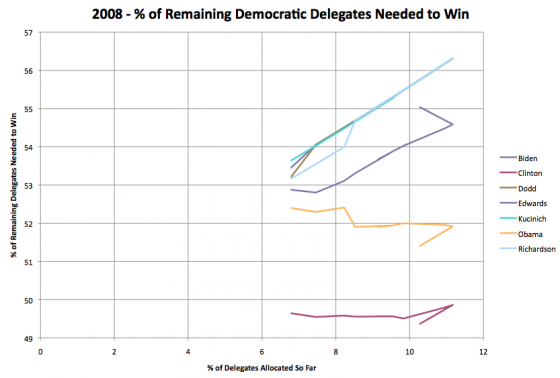
There are a few oddities in the data from back then… my sources had allocated some delegates, then backtracked, causing the little bit of backtracking on the chart, and when my tracking started on January 1st almost 7% of the delegates were already in place because of Super Delegates who had declared their preferences)… but you can still see the trends.
So, most important thing you see here… Clinton was still in the lead! Obama didn’t catch her in delegates until significantly later. But it is clear that both Obama and Clinton are still in contention. Their lines are basically horizontal, and they were pretty close to each other. Neither of them had started moving toward the nomination really, but neither was showing a pattern of getting eliminated either… like Edwards and all the rest were.
In this year’s race, all of Romney’s competition are in worse positions than McCain’s competition was at the same time. It is not yet too late for one of them to mount a push and catch up… but it is getting close. Even with the vastly stretched out schedule, there is still a big enough chunk of states coming up on Super Tuesday that we’ll probably see that day be the do or die day for all the not-Romneys. At least for actually catching up and winning. Blocking Romney from 1144 is a lot easier task than actually winning at this point. We’ll know a lot more about how possible (or not) that scenario is after Super Tuesday as well.
OK, long post, but finally, for reference, here are the two races in 2008 in full as they played out (rather than just looking at the first 12%).
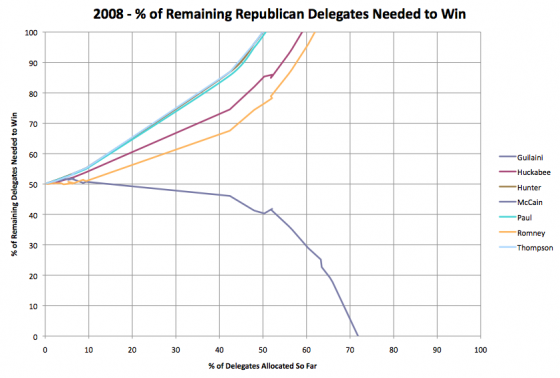
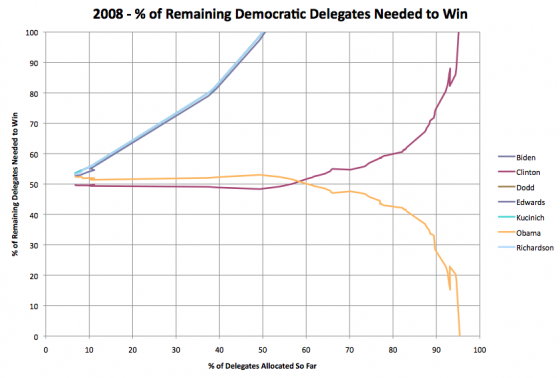
And here is this year’s Republicans at the same scale…
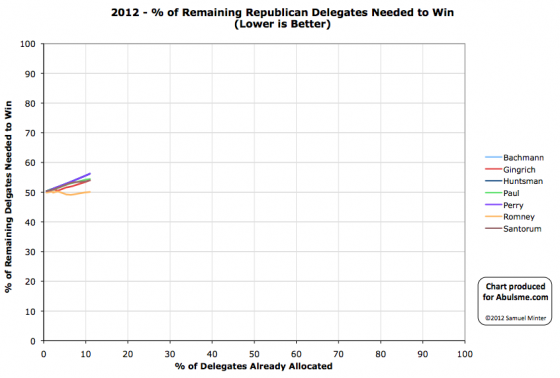
Just a little ways left to go, huh?
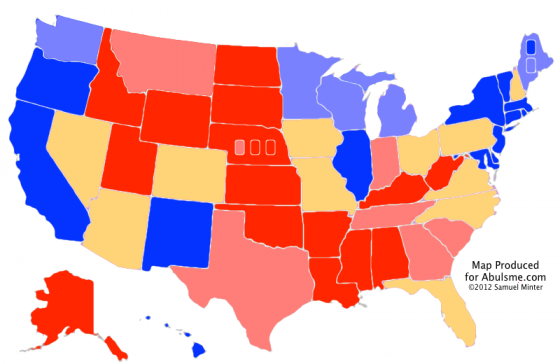
Map from the Abulsme.com 2012 Electoral College Prediction page.
So, a new poll in Washington state moves Obama’s 5 poll average from a lead just a little more than 10%, to a lead just under 10%. To be fair, this is the 5th real poll I have, so this for the first time moves the 2008 election results used to seed the averages out, and makes this the first look that is based solely on Obama vs Romney polling. It does though move Washington from the “Strong Obama” category down to my “Weak Obama” category. I keep thinking maybe I should rename the categories, because a 9.5% lead isn’t exactly all that “Weak”. But leads that size have been known to disappear via strong campaigning, major events in the campaign, etc. The right way to interpret this category is “Candidate has a decent lead, but not so huge they can take the state for granted.” My name just sucks a little. :-)
In any case, since this doesn’t effect a swing state, this doesn’t move the basic numbers of the race:
|
Romney |
Obama |
| Romney Best Case |
311 |
227 |
| Current Status |
210 |
328 |
| Obama Best Case |
170 |
368 |
This is the first movement on our charts toward Romney since January 11th though, so that is worth noting.
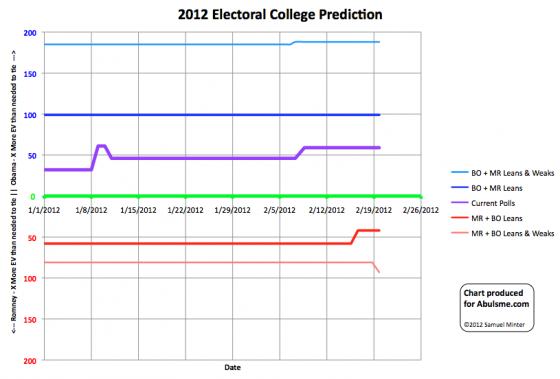
Chart from the Abulsme.com 2012 Electoral College Prediction page. Lines represent how many more electoral votes a candidate has than is needed to tie under several different scenarios.
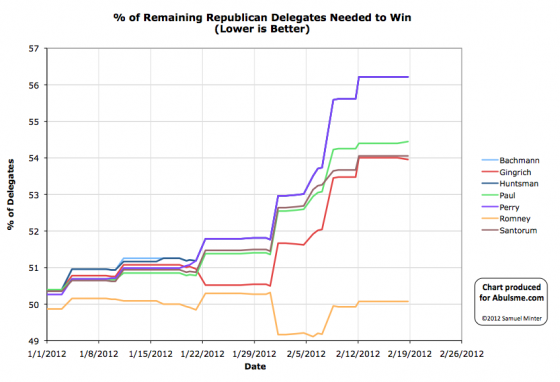
Chart from the Abulsme.com 2012 Republican Delegate Count Graphs page. When a candidate gets down to 0%, they have cinched the nomination. If they get up past 100%, they have been mathematically eliminated.
A small change today. Maine revised its preference poll numbers to add some precincts whose results got lost in a spam folder (really). The result from this is that the delegate estimates give one less delegate to Paul, and one more to Gingrich. So Gingrich wins the day today.
But Maine’s results will change again. First, there are still more precincts who haven’t done their votes yet (or are doing them today). So there may well be more straw poll Maine updates to come.
More importantly though, these are only estimates based on the straw polls, in fact, no delegates have been selected at all yet. In fact, delegates to the state convention were selected, who in turn will select delegates to the national convention. That won’t happen until MAY. Estimates of what will happen in May really should be based on asking each of the delegates to the next level of the process who they intend to support. But nobody seems to be doing that sort of things, so instead we (well, Green Papers) base estimates on the straw polls. But the real results may be very different. You may have someone like Paul out organizing and getting an outsized number of delegates compared to the star poll (the Paul campaign claims they are on track to do this), or, you may have the nominee being a done deal by May, and get all delegates allocated to the obvious winner, regardless of what happened in February.
Anyway, with the best estimate we have as of when I pulled the numbers a couple hours ago, today Gingrich gains a delegate and Paul loses one.
Edit 2012 Feb 18 23:10 – Minor wording change
| In the latest Curmudgeon’s Corner…
Sam and Ivan talk about:
- Republicans
- Econ Update
- iPad 3 Rumors
- Data Throttles
Just click to listen now:
[wpaudio url=”http://www.abulsme.com/CurmudgeonsCorner/cc20120212.mp3″ text=”Recorded 12 Feb 2012″]
or
 1-Click Subscribe in iTunes 1-Click Subscribe in iTunes
 View Podcast in iTunes View Podcast in iTunes
 View XML Feed View XML Feed
|
 |
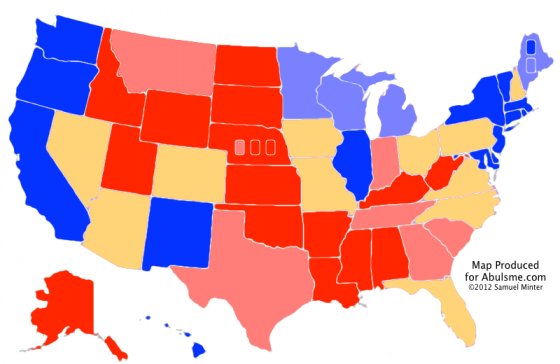
Map from the Abulsme.com 2012 Electoral College Prediction page.
I’ve switched the color of the swing states to gold to make them stand out more. Also note this analysis is strictly Obama vs Romney. If some other candidate takes the delegate lead on the Republican side, I’ll start an analysis for them too, but not before.
The big change today is that a new poll moves my five poll average for Michigan to a greater than 5% lead for Obama. This takes it out of my “Lean Obama” swing state category and into the “Weak Obama” category, meaning that Obama has a nice lead in the state, but not so large he can take it for granted.
In terms of the range of outcomes that seem possible (again, if the election were held today, which it won’t be, and a lot will happen before November), we consider as the extremes of what is likely all the swing states going one way or the other. This is a highly unlikely outcome in and of itself, but it serves to bound the range of possible outcomes. With Michigan slipping out of the swing state category, this means Romney’s best case scenario is now Romney 311 – Obama 227. To achieve this he would need to win all the states where he is currently ahead in polling, and also pull Florida, Pennsylvania, Ohio, Virginia, Colorado, Iowa and Nevada away from Obama.
The situation if everybody wins the states they are currently ahead in remains Obama 328 – Romney 210.
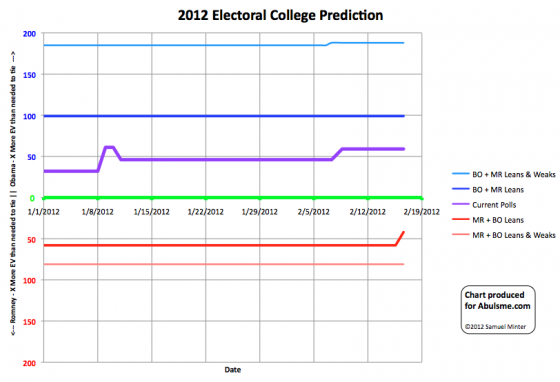
Chart from the Abulsme.com 2012 Electoral College Prediction page. Lines represent how many more electoral votes a candidate has than is needed to tie under several different scenarios.
I couldn’t stop thinking about it, so another thought comparing the Republican race now versus 2008. This was also first posted as a comment on the Primary Season Amnesia post on Chris Weigant’s blog.
One more follow up thought… it really is very important that the calendars are so different between this year and 2008… so let me explicitly do the conversion. As of today, 2012 Feb 14, we have 10.98% of the available delegates allocated or estimated. The closest comparison we would have had in 2008 was February 4th and 5th, at which point 9.41% of the available delegates had been allocated.
On that day… McCain was ahead of Romney, but just barely. McCain had 43.3% of the delegates so far (and needed 50.7% of the remaining delegates to win). Meanwhile Romney was his closest competition and right behind… 41.1% of the delegates so far (and 51.0% of the remaining delegates needed to win.) This was still a race. These guys were very close to each other at that point. (Unlike this year, where Romney has a very substantial lead on Gingrich at this point.)
So if anything, at a comparable point in the delegate race (as opposed to the time of year) Romney is actually MUCH better off than McCain was at the same point. Gingrich is much further behind Romney than Romney was behind McCain. Romney and McCain were neck and neck. Gingrich is nowhere close to Romney in delegates, and everybody else is even further behind.
But February 5th was Super Tuesday. It took several days for all the delegate estimates from Super Tuesday to be complete… but most of them were in by February 8th, and no other primaries or caucuses had happened yet. At that point 50.29% of the delegates had been allocated. McCain now had 59.6% of the delegates so far, and only needed 40.3% of the remaining delegates to get to the magic number and win the nomination. Romney by contrast, now had only 23.9% of the delegates and needed a full 76.5% of the remaining delegates to catch up and win.
So post-Super Tuesday, McCain could do worse than he had done so far by a 20% margin and still win. But Romney needed to more than triple how he had been doing in the delegate count to catch up and win. These are again the kind of numbers where the press will still call it a race because it is fun, but the reality is that in order to close that kind of gap the front runner essentially has to totally collapse AND things have to go very very right for their challenger too…
As for this year, things are MUCH more spread out. After Super Tuesday we’ll still only have some 35% of the total delegates allocated, as opposed to over 50% in 2008. So even if after super Tuesday, Romney is finally starting to get his “% of remaining needed to win” to come down instead of staying flat, he’ll have a decent slog to actually collect the 1144 delegates. If he still is hovering around 50% of the delegates (or less!) at that point instead of routinely winning more than half of the delegates, then we’ll have quite a nice bit of fun before we get to the end of this, and the possibilities of brokered conventions start becoming more real.
But in terms of the delegate race, in comparison to 2008, it is really very early. On February 14th 2008, 56.55% of the delegates were already allocated. We won’t get to that point in 2012 until the end of March or beginning of April (depending on how fast super delegates announce their positions). It was very front loaded last time. This time it is very stretched out….
This morning I saw a post referring back to 2008 race. The part that caught my attention was this:
Primary Season Amnesia
(Chris Weigant, 2012 Feb 13)
Even accounting for such differences, the 2008 race was still a very close three-way contest in early February. Romney and McCain were almost even in states won, with Huckabee not all that far behind. This year, Mitt Romney has won four states, Rick Santorum four, and Newt Gingrich one.
You’d think the media would remember these facts, but (once again) we are being subjected to endless stories about how downright unique the 2008 Republican primary season is, along with the exact same storylines that ran in 2008 about the frontrunner not being able to close the deal, especially with conservative voters. McCain, back then, raised just as many suspicions among the conservative Republican base that he “wasn’t one of us” that Romney now hears.
I had to respond, as while I have no doubts that the media narrative was all about McCain still having trouble closing, the delegate numbers just didn’t support that story. (The media would do the same thing months later while they continued to talk breathlessly about the Obama vs Clinton race long after it was mathematically clear that it would take an absolute unprecedented miracle for Clinton to actually catch up and win.) Anyway, I posted the following as a comment at Chris Weigant’s site. (Awaiting moderation as I post this on my site.)
Sorry for the really long comment… probably should just post on my blog. :-)
The media narrative in 2008 at this point in time may well have been that McCain was having problems closing the deal, but looking at delegate counts, there was a very different story. There was NOT a close three way race in mid-February. Take a look at my page showing how the delegate race played out in both parties last time around:
http://wiki.abulsme.com/2008_Presidential_Delegate_Graphs#Republicans
By this time in February (indeed, essentially immediately following Super Tuesday, but he continued to consolidate after) McCain had essentially already put this away.
The key thing I use to measure this is the percent of the remaining delegates available that the candidate would need to cinch the nomination. This takes into account both what the candidates already have gotten, and the dwindling number of remaining delegates available to catch up. At this point in February 2008, McCain had amassed a big enough lead that he had over 60% of the delegates allocated thus far, and only needed about 35% of the remaining delegates to clinch the nomination. In other words, he could do much worse than his record up to that point and still win. By comparison, at this point his closest competition was Romney, who had collected about 22% of the delegates so far, and would have needed to get about 87% of the remaining delegates to catch up and win. 87%!!!! Compared to the 22% he had managed so far! This was not a realistic outcome absent a major McCain collapse or scandal… and probably the other candidates dropping out too.
Starting with Super Tuesday last cycle, you can see the clear pattern of McCain completely dominating the race and all other opponents just falling further and further behind while McCain races toward clinching the nomination. Any narrative about him not closing the deal was just not borne out by the numbers.
As you pointed out, the HUGE difference is that we have had less states and a smaller percentage of the delegates allocated so far. Even super Tuesday will be smaller than last time, everything is just more spread out that last time, which means in terms of TIME (as opposed to states) one would of course expect it to take longer for things to settle.
(And indeed perhaps, really, the better time to compare to would have been mid to late January in 2008, when things really were still more unsettled and less states had voted… McCain only even took the delegate lead from Romney on January 30th or so…)
But sticking with February and comparing this year:
http://wiki.abulsme.com/2012_Republican_Delegate_Count_Graphs
Looking at the “% of remaining needed to win” you see all the non-Romney’s rapidly heading upward. With each contest (with the exception of Newt’s win in South Carolina) even if they win, they aren’t winning by big enough margins to be on a pace to actually win the nomination outright. Meanwhile though, there is a big difference from 2008. Rather than Romney’s numbers indicating that he is getting an easier and easier path to the nomination after each state as he gains more and more delegates, we see him hovering around 50%. Right now he is slightly under. (I should say at this point that I use the delegate estimates from the primaries and caucuses by The Green Papers, and the Super Delegate estimates from Democratic Convention Watch.) Romney is staying flat, but to “close the deal” in terms of winning outright before the convention, he has to actually start collecting delegates at a slightly faster pace than he has been so far.
Right now Romney’s closest competition is still Gingrich (although Santorum is closing fast). Right now Gingrich has 17.9% of the delegates so far, and would need to get 54.0% of the remaining delegates remaining to catch up and win. (Santorum and Paul would have to do even better than that.) Now, 54.0% is not an outrageous number, but it is more than three times better than he has been doing so far!!! If that were to start to happen (or the equivalent with the other candidates) it would be a HUGE change compared to what has happened so far in the race. And it would have to happen soon, because if not, that 54% is just going to rise and it will get harder and harder to catch up. One of the other candidates catching up and winning is not impossible, but it would take a major seismic shift changing the dynamics of the race. Perhaps Gingrich continuing to drop rapidly with Santorum picking up most of his support, winning Michigan and getting momentum out of that going into Super Tuesday would do that… but it still needs to be a big change for one of these guys to catch up.
Meanwhile, so far Romney has 49.8% of the delegates so far, but would need 50.1% of the remaining delegates to close the deal. So he has to improve his performance, but just by a LITTLE bit in order to be on pace to actually win the nomination… a few nice big winner take all states would most likely be enough to do the trick. But he is NOT putting it away or closing the deal yet. If all the not-Romney’s combined keep operating at about the level they have been, Romney would get to the convention just short of the 1144 delegates he needs.
Now, there is a long time between now and then, and if he wins the winner take all states and doesn’t completely collapse in the proportional states, he should be able to do that “little bit better” that he needs and wrap this up. At the moment though, none of his competition are in a position to actually WIN unless there are dramatic changes in the dynamics of the race (for instance one of them drops out), but they ARE in a position to block Romney from getting 1144 if they continue to do as well or better (collectively) as they have so far…
(In 2008 at this point, all of McCain’s competition combined were not in a realistic position to even keep him from getting the magic number, let alone catching up to win.)
None of this means I’m predicting a brokered convention… yet. But if Romney is still above 50% of remaining delegates needed after we pass Super Tuesday… then I’ll start to look at that as a realistic possibility. Until then, he is still actually the front runner, although he has clearly lost some momentum.
But Arizona is winner take all, and he is still way ahead there. Michigan is proportional, so chances are even if Santorum wins, it won’t be by enough to actually be on a pace to catch up. A win there would clearly put Romney in danger on Super Tuesday though. But more immediately Arizona is the one to watch because it is winner take all. If Romney wins that, then he consolidates his lead, regardless of what happens in Michigan. If Romney LOSES there… then he is in real trouble.
I’ll note that we also talked a bit about this topic on the episode of the podcast that Ivan and I recorded on Sunday and that I haven’t posted yet (sorry!) but will probably (hopefully!) post tomorrow.
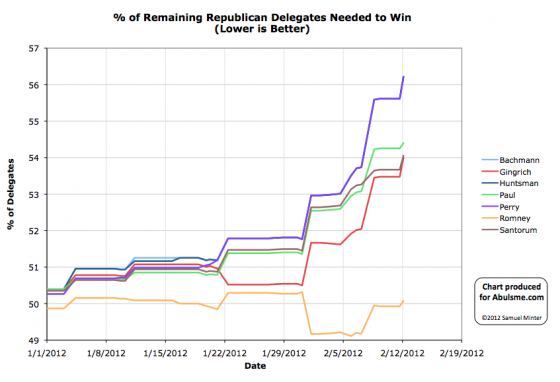
Chart from the Abulsme.com 2012 Republican Delegate Count Graphs page. When a candidate gets down to 0%, they have cinched the nomination. If they get up past 100%, they have been mathematically eliminated.
So. Maine. A few things to say before looking at any numbers here. Maine is another of those states where no actual delegates were designated by the initial caucuses there. Instead, two things happened. First, there was a straw poll. Second, there was the elections to the delegates of the next round. The second thing is actually related to who eventually gets delegates when all is said and done months from now. The first does not. At all. But it is what is reported because it is an easy to understand result. Also, it should be said that some precincts in Maine haven’t even had their caucuses yet. They don’t get to participate in the straw poll (because it is over) but they will get to vote on delegates and such. The “real” result tonight, as in many of the caucus states, is that no delegates at all have been allocated yet.
For this site, we use estimates from The Green Papers for delegates. These assume that the eventual delegate allocation will be proportional to the straw poll results, at least at first approximation. When later rounds of the delegate selection process happen, the numbers will get revised and may be quite different. As an example, the Ron Paul campaign is saying that they think in the end they will actually get the most delegates from Iowa, Minnesota and Colorado because they had their people stay around after the straw polls and actually run to be delegates to the later stages while the other campaigns for the most part ignored this. We shall see how that plays out. In the mean time, while one can look at only completely determined delegates like DCW does in their primary count, but we’ll use the projected eventual delegates from caucus states until better numbers are available later in the process…
Anyway, now on to the main event. Since the last update, we had the preliminary Maine results (estimated as described above), and Ron Paul gained one superdelegate. So for the day, Paul gains 9 delegates, Romney 8, Santorum 4 and Gingrich 1. So Paul wins the day, right? Or maybe like most people saying, it is a win for Romney since he got the most actual votes in the straw poll?
Wrong. The right answer is that after today EVERYBODY is further away from the nomination than they were yesterday. (Paul just lost the least ground.) Nobody got a high enough percentage of the delegates from today to be on track for getting to 1144 delegates before the convention. The delegate take is continuing to be split in such a way that nobody is taking a majority of the delegates.
In fact, with these results, Romney slips below 50% of the delegates allocated so far for the first time since his big delegate win from the winner take all contest in Florida. Prior to today, if he just continued getting delegates at the same percentage he had been so far, he would win the nomination. Since he is now below 50% again, that means he has to actually improve his performance above his historical levels (slightly) to get to 1144.
Of course we have another winner take all state (Arizona) coming up soon, and that may help Romney’s situation considerably if he wins there (as the current polls indicate is likely).
It is also worth pointing out though that even though Romney’s real position in the race (in terms of % of remaining delegates needed to win) was hurt today like everybody’s else’s… the gap between him and his closest competition (still Gingrich, despite Santorum closing rapidly) continues to grow. Romney now needs 50.1% of the remaining delegates to get to 1144. This is just slightly better than the 49.8% he has gotten so far. By comparison, Gingrich now needs 54.0% to catch up and actually get to 1144. This would be a huge change from the 17.9% he has managed so far.
As long as Romney is hovering around 50% of the delegates rather than consolidating and heading rapidly north of that number, we’re going to be hearing the talk about him not managing to get to 1144 and thus potentially ushering in the first brokered convention in decades. While this is an exciting possibility, the road there is still narrow, and Romney is still very much in shooting distance of an outright win.
If however as we hit the next few contents, we see his “% of remaining delegates needed to win” number staying above 50% and actually start to trend consistently UPWARD rather than flat or down… then that talk starts to be more of a real possibility.
|
|




















